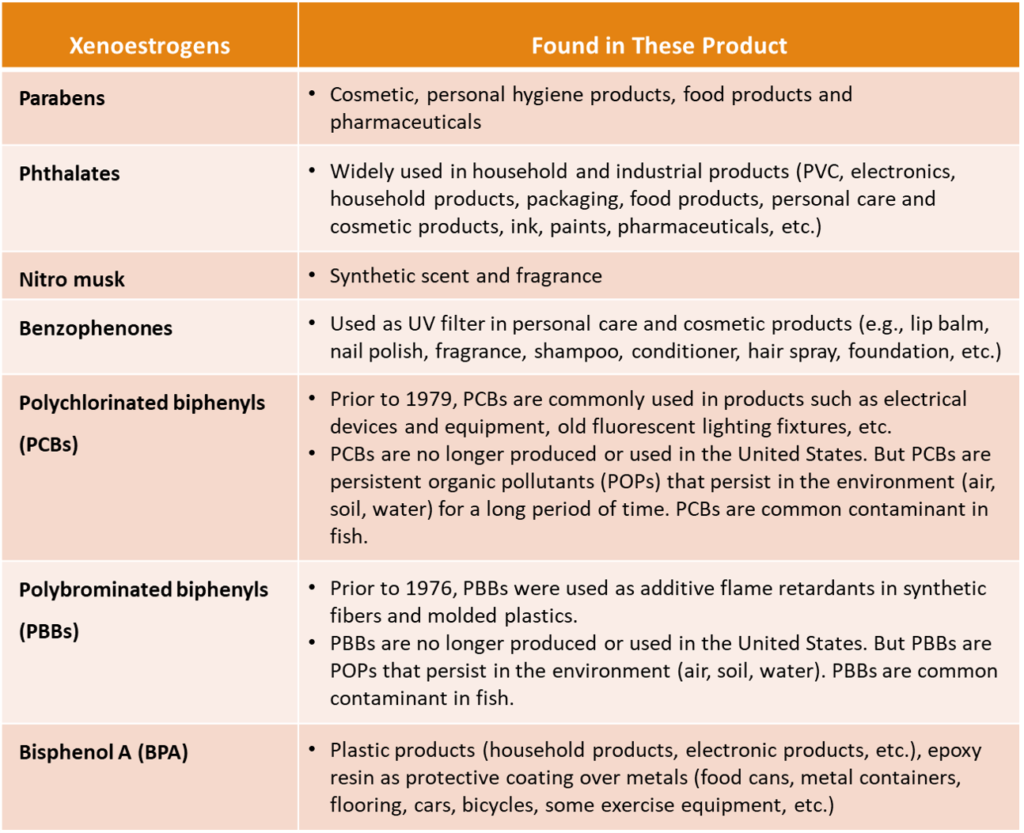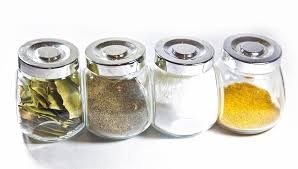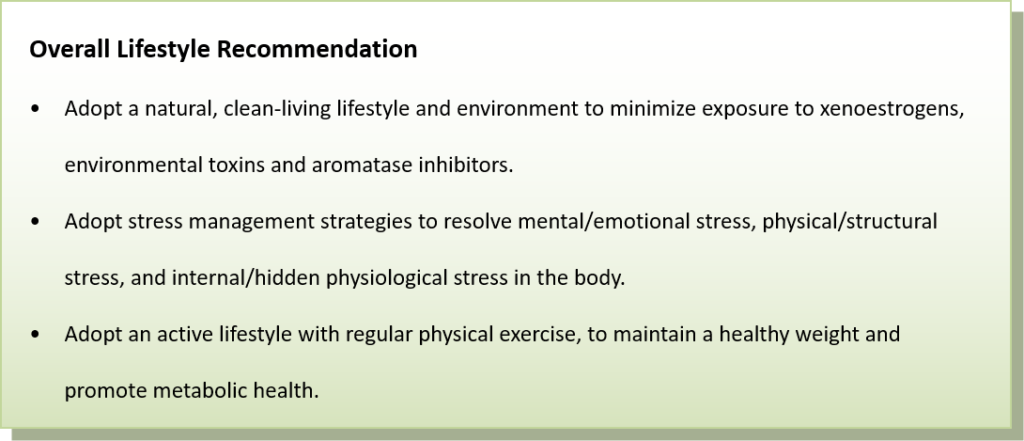Lifestyle factors play important roles in the balance of estrogen and progesterone, two major female sex hormones.
The balance of these two hormones play vital roles to many aspects of women’s health, not just reproductive health.
There are two main manifestations of imbalance between estrogen and progesterone, namely:
- Estrogen excess or dominance (i.e., high estrogen-to-progesterone ratio)
- Estrogen deficiency.
These manifestations can result in many disorders and health challenges.
See Female Hormonal Health: The Fine Balance for more details on the contributing factors and health disorders associated with estrogen-progesterone imbalance.
Diet and nutrition can help to regulate the balance of estrogen and progesterone (see Diet and Lifestyle for Female Hormonal Health).
A healthy lifestyle can also help to mitigate factors contributing to estrogen excess/dominance and estrogen deficiency as described in this article.
Lifestyle Approaches for Estrogen Excess/Dominance
Key factors contributing to estrogen excess/dominance include (see details in Female Hormonal Health: The Fine Balance):
- Xenoestrogen exposure
- Ineffective clearance of excess estrogen in the body
- High levels of unbound/bioavailable estrogen in the blood
- Perimenopause
- Chronic inflammation
- Excessive alcohol consumption
- Stress
In addition to adequate diet and nutrition, many of these factors can be mitigated through lifestyle choices.
Minimize/Reduce Exposure to Xenoestrogens
Xenoestrogens are externally present or foreign compounds that exert estrogenic effects in the body and has been shown to contribute to estrogen excess/dominance and detrimental health effects1.
Xenoestrogens can be synthetic or natural occurring substances.
Synthetic xenoestrogens are widely used industrial chemicals including parabens, phthalates, nitro musks, benzophenones, polychlorinated biphenyls (PCBs), polybrominated biphenyls (PBBs), bisphenol A (BPA), pesticides, fungicides and fire retardants that are often found in environmental pollutants, food additives and preservatives, personal care and cosmetic products, and household consumables.
See Table 1 below on the list of synthetic xenoestrogens and what products may contain them.3–5
Table 1. Industrial Chemicals and What Products May Contain Them

Oral contraceptives and hormone replacement therapy (HRT) are also xenoestrogens.
Synthetic HRT have been shown in large population clinical studies to increase the risks of heart disease, breast cancer and dementia.3 The American Heart Association advises that if HRT is used for the treatment of significant menopausal symptoms, the lowest dose for the shortest possible duration should be used.4


Lifestyle measures to minimize exposure to synthetic xenoestrogens include:
- Adopt a clean-living lifestyle by using natural personal care and cosmetic products, and household products. Refer to the Environmental Working Group website (ewg.org) for consumer guides on various personal and household products.
- Avoid using BPA plastic containers.
- Avoid usage and exposure to pesticides/fungicides/herbicides.
- Use alternative and natural contraception methods that do not disrupt hormones.
- Use HRT only if needed, and with caution and close monitoring
Reduce and Adequately Manage Stress
Chronic stress elevates cortisol levels, which in turn can deplete progesterone levels, potentiating estrogen dominance.
On the other hand, estrogen excess/dominance can hyperactivate stress response in the body and elevate cortisol levels.
Therefore, chronic stress and estrogen excess/dominance can form a vicious cycle.
Stress is multifaceted, not just mental/emotional stress (see more details in Why Stress is the Culprit).
Prominent stressors include:
- Physical injuries/trauma,
- Over-exercise
- Sleep deprivation
- Inappropriate diets
- Digestive problems
- Food sensitivities/intolerance/allergies
- Infections
- Chronic inflammation
- Environmental toxins
Lifestyle measures to reduce and adequately manage stress include:
- Address mental and emotional stress through stress reduction and relaxation techniques such as yoga, meditation, Tai Chi, diaphragmatic breathing techniques, adequate physical exercise, music therapy, nature therapy, massage therapy, etc.
- Address any physical/structural issues to the body.
- Avoid over-exercising and over-exertion.
- Ensure adequate rest and sleep (7-8 hours of good quality sleep per night).
- Eat a clean, whole-food, nutrient-dense diet (see Diet and Nutrition for Female Hormonal Health)
- Address digestive issues, food sensitivities/intolerance/allergies and other gut health issues (see Why Your Gut-Feeling Matters).
- Avoid or minimize exposure to environment toxins in living environment including foods, and personal care, cosmetic and household products.
Exercise and Weight Management
Studies have shown that obesity and lack of exercise are major contributors to insulin resistance and type 2 diabetes, which in turn contribute to increased unbound/bioavailable estrogen in the blood serum and potentiate estrogen excess/dominance.1,8
Obesity also contributes to chronic inflammation that potentiate estrogen biosynthesis. 1
Therefore, weight management through adequate diet and exercise is important.
Adequate level of physical activity through physical exercise and adopting a more active lifestyle not only can help with weight management, but also reduces the risk of chronic diseases including type 2 diabetes, metabolic syndrome and cardiovascular diseases such as high blood pressure and heart disease.8–10
The key should be to avoid physical inactivity. Some physical activity is better than none. Even a small amount of physical activity and exercise can be beneficial for health and preventing further weight gain.
For more substantial health benefits, the current Physical Activity Guidelines for Americans9 recommend that
- Adults should do at least 150 minutes (e.g. 30 minutes per day for 5 days a week) of moderate-intensity or 75 minutes of vigorous-intensity aerobic physical activity per week.
- Muscle-strengthening activities should also be incorporated for two or more days a week.
Examples of moderate-intensity activities include brisk walk, recreational swimming, slow bicycling (less than 10 miles per hour), active form of yoga, yard work, ballroom/line dancing, etc.
Examples of vigorous intensity activities include jogging/running, swimming laps, faster bicycling (more than 10 miles per hour), hiking (uphill), high-intensity interval training (HIIT), etc.
Some measures to incorporate physical activities into daily life:

- Start small, if you are currently physically inactive, by incorporating more walking into daily life, e.g., walk instead of taking transportation or elevator, take a lunch-break walk or after-work walk.
- Engage in hobbies that involve physical activity, e.g. gardening, nature walk, spending active time with family outdoor, etc.
- Take up exercise classes or exercise routine that you know you enjoy and will be able to sustain.
- Find an exercise partner or community (e.g. running group, hiking group, etc.) for mutual support and encouragement.
- Find the intrinsic joy and the feeling of wellbeing through your choice of exercise. It is easier to sustain a routine when we intrinsically enjoy doing it and experience the mental and physical benefits from it.
Lifestyle Approaches for Estrogen Deficiency
Key factors contributing to estrogen deficiency include menopause and exposure to chemicals that inhibit the enzyme, aromatase, responsible for the synthesis of estrogen (see details in Female Hormonal Health: The Fine Balance).
Menopause can be due to normal aging process, ovariectomy or premature ovarian failure. Both estrogen and progesterone are depleted during postmenopause.1
Lifestyle approaches for non-menopause related estrogen deficiency should focus on minimizing exposure to aromatase inhibitors unless deemed medically necessary.
Aromatase inhibitors are found in12:
- Many pharmaceutical drugs, including antidepressants, antipsychotics, anticonvulsants opiates, anti-androgens, anti-hypertensive drugs, H2-receptor antagonists, antimalarials, anticancer drugs, and immunosuppressive drugs comprising glucocorticosteroids and methotrexate.
- Herbicides such as glyphosates and Roundup.
- Azole compounds in agricultural antifungals.
- Cigarette smoke.
Summary: Overall Lifestyle Recommendation

You can learn more here about how Functional Health Coaching can help you uncover the hidden stressors and the underlying causes contributing to your hormonal imbalance and use holistic diet, nutrition and lifestyle protocol to bring your body back to balance.
Related Articles
Female Hormonal Health: The Fine Balance
Diet and Nutrition for Female Hormonal Health
References
- Fong M. Female hormonal health: The fine balance. Simply Radiant Living. http://www.simplyradiantliving.com/female-hormonal-health-the-fine-balance/. Published 2018.
- Fong M. Diet and nutrition for female hormonal health. Simply Radiant Living. http://www.simplyradiantliving.com/diet-and-nutrition-for-female-hormonal-health/. Published 2018.
- S. Environmental Protection Agency. https://www.epa.gov/.
- Environmental Working Group. https://www.ewg.org/.
- Campaign for Safe Cosmetics. http://www.safecosmetics.org/.
- Boardman H, Hartley L, Eisinga A et al. Hormone therapy for preventing cardiovascular disease in post-menopausal women. Cochrane Database of Systematic Reviews. 2015. doi:10.1002/14651858.cd002229.pub4
- American Heart Association. Menopause Hormone Treatment, Heart Risk. Go Red For Women®. https://www.goredforwomen.org/know-your-risk/menopause-heart-disease/menopause-hormone-treatment-heart-risk/. Published 2018.
- Altaf Q, Barnett A, Tahrani A. Novel therapeutics for type 2 diabetes: Insulin resistance. Diabetes, Obesity and Metabolism. 2014;17(4):319–334. doi:10.1111/dom.12400
- Blumenthal JA, Babyak MA, Hinderliter A, Watkins LL, Craighead L, Lin PH, Caccia C, Johnson J, Waugh R, Sherwood A. Effects of the DASH diet alone and in combination with exercise and weight loss on blood pressure and cardiovascular biomarkers in men and women with high blood pressure: the ENCORE study. Arch Intern Med. 2010;170(2):126-35. doi: 10.1001/archinternmed.2009.470
- Eckel RH, Jakicic JM, Ard JD, de Jesus JM, Houston Miller N, Hubbard VS, Lee IM, Lichtenstein AH, Loria CM, Millen BE, Nonas CA, Sacks FM, Smith SC Jr, Svetkey LP, Wadden TA, Yanovski SZ; American College of Cardiology/American Heart Association Task Force on Practice Guidelines.. 2013 AHA/ACC guideline on lifestyle management to reduce cardiovascular risk: a report of the American College of Cardiology/American Heart Association Task Force on Practice Guidelines. J Am Coll Cardiol. 2014 Jul 1;63(25 Pt B):2960-84. doi: 10.1016/j.jacc.2013.11.003
- Office of Disease Prevention and Health Promotion. Physical activity guidelines for Americans, 2nd edition. Health.gov. https://health.gov/paguidelines/second-edition/pdf/Physical_Activity_Guidelines_2nd_edition.pdf. Published 2018.
- Patel S, Homaei A, Raju A, Meher B. Estrogen: The necessary evil for human health, and ways to tame it. Biomedicine & Pharmacotherapy. 2018;102:403-411. doi:10.1016/j.biopha.2018.03.078

